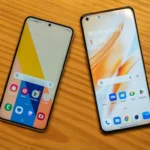
When it comes to the OnePlus 13 vs Pixel 9 Pro comparison, battery life immediately stands out as a game-changer. The OnePlus 13 delivers nearly 10.5 hours of screen-on time with its massive 6,000mAh battery, while the Pixel 9 Pro manages just five to six hours from its smaller 4,700mAh capacity.
The Pixel vs OnePlus battle extends beyond just battery performance. Despite being priced $199 higher at $1,099, the Pixel 9 Pro falls significantly behind in raw power, scoring only 1,148,512 on AnTuTu compared to the OnePlus 13’s impressive 2,905,105. However, Google compensates with an industry-leading seven years of software updates, edging out OnePlus’s six-year commitment.
We’ve thoroughly tested both flagships to help you decide which offers better value. From the OnePlus 13’s lightning-fast charging (0-50% in just 13 minutes) to the Pixel’s photography capabilities with its 48MP telephoto lens, each device brings distinct advantages to the table. If you’re planning to invest in a premium smartphone in 2025, our detailed comparison will help you make the right choice based on what matters most to you.
Specs and Configuration Overview
The hardware specifications reveal significant differences between these two flagship devices. Looking at raw numbers alone provides a clear picture of what each manufacturer prioritizes in their premium offering.
Storage Variants: 256GB/512GB vs 128GB to 1TB
The OnePlus 13 takes a bold approach to storage, eliminating lower-capacity options entirely. It starts at a generous 256GB using the faster UFS 4.0 standard and offers a 512GB variant for those needing more space. In contrast, the Pixel 9 Pro gives customers more flexibility with four storage tiers: 128GB, 256GB, 512GB, and a massive 1TB option. Nevertheless, Google uses the slightly older UFS 3.1 standard which, although fast, doesn’t match OnePlus’s storage performance.
Price-conscious buyers should note that OnePlus provides better value for initial storage—USD 900 gets you 256GB with OnePlus versus USD 1,099 for just 128GB with the Pixel. Additionally, Google appears to use storage as a pricing strategy with significant jumps between tiers: USD 1,099 for 128GB, USD 1,199 for 256GB, USD 1,319 for 512GB, and USD 1,449 for the 1TB model.
RAM Options: 12GB/16GB vs 16GB
Memory configuration is another area where these phones diverge substantially. The OnePlus 13 offers two RAM configurations—12GB in the base model and 16GB in the higher-tier variant. Google, conversely, standardizes all Pixel 9 Pro models with 16GB RAM regardless of storage capacity. Both devices utilize the latest LPDDR5X RAM technology for optimal performance.
For practical everyday use, both phones provide more than enough memory for multitasking. Yet, power users who frequently jump between demanding applications might appreciate the consistency of the Pixel’s 16GB across all models.
Color Choices and Build Materials
OnePlus offers the 13 in three distinctive colorways: Black Eclipse, Midnight Ocean, and Arctic Dawn, though the base 12GB/256GB variant is only available in Black Eclipse. What’s particularly interesting is the Midnight Ocean variant’s unique eco-leather back, offering both better grip and a distinctive premium feel compared to the glass backs on other variants.
The Pixel 9 Pro counters with four color options: Obsidian, Porcelain, Hazel, and the limited Rose Quartz (available only in the 256GB model). All Pixel variants feature a glass back made from Corning Gorilla Glass Victus for enhanced durability.
Both phones employ aluminum frames, but their design languages differ significantly. OnePlus places its camera assembly in a prominent circular housing in the upper-left corner, whereas Google’s horizontal camera bar spans almost the entire width of the device. Durability-wise, the OnePlus 13 edges ahead with an IP69 rating compared to the Pixel 9 Pro’s IP68 certification.
Display and Visual Quality
“These displays have set a high bar for future Android devices that only a few others can achieve.” — Derrek Lee, Senior Staff Writer at Android Police
The visual experience forms the cornerstone of any premium smartphone, and both the OnePlus 13 and Pixel 9 Pro offer exceptional displays with distinct advantages. Looking beyond basic specifications reveals how these screen technologies translate to everyday usage.
Resolution and Pixel Density: 510ppi vs 495ppi
The OnePlus 13 boasts a 6.82-inch LTPO AMOLED display with a resolution of 1440 x 3168 pixels, resulting in a sharp 510 pixels per inch (ppi) density. Meanwhile, the Pixel 9 Pro features a slightly smaller 6.3-inch LTPO OLED panel with 1280 x 2856 resolution and 495 ppi.
This difference in pixel density, while modest, becomes noticeable when viewing detailed content or reading small text. The OnePlus 13 also offers approximately 17% more screen space overall, making it better suited for media consumption and multitasking. Both devices maintain the same 20:9 aspect ratio, ensuring consistent content formatting across both phones.
Brightness and Outdoor Visibility
Regarding brightness capabilities, the specifications present an interesting contrast. The OnePlus 13 achieves an impressive 4,500 nits peak brightness in HDR content and 1,600 nits in high brightness mode (HBM). In comparison, the Pixel 9 Pro reaches 3,000 nits peak brightness and 2,000 nits in HDR content.
For practical outdoor visibility, both phones perform admirably under direct sunlight. As one analysis notes, “Subjectively, both phones get plenty bright under direct sunlight, and due to the way the human eye perceives brightness, the 300-nit difference is not as dramatic as it might seem”. Effectively, either device will remain easily visible in challenging lighting conditions.
Color Accuracy and Calibration
Both flagships deliver excellent color performance with support for the DCI-P3 color gamut. The OnePlus 13 covers 99.6% of the RGB color space versus the Pixel 9 Pro’s 99.1%. Consequently, in real-world usage, both phones offer vibrant yet accurate colors.
Nevertheless, the Pixel 9 Pro tends toward more natural color reproduction, whereas the OnePlus 13 delivers slightly punchier colors. Furthermore, both devices support HDR10+, but the OnePlus 13 adds additional Dolby Vision support, enhancing compatible streaming content.
Touch Sampling Rate and Responsiveness
Touch responsiveness remains crucial for everyday interactions. Both devices feature a fast 120Hz adaptive refresh rate that can scale down to 1Hz for static content. This results in smooth animations and scrolling while preserving battery during less demanding tasks.
Concerning touch sampling rate—how quickly the screen registers your touch inputs—both devices offer excellent responsiveness with a 2ms response time. This ensures minimal input lag when gaming or navigating through the interface.
For display protection, the OnePlus 13 uses Ceramic Guard, while the Pixel 9 Pro employs Corning Gorilla Glass Victus 2. Both technologies provide strong scratch and impact resistance, essential for daily usage.
Camera Performance in Real Life

Image Source: Gazelle
“The level of detail is similar on both phones, but the OnePlus tends to make photos look oversaturated and oversharpened.” — Victor Hristov, Senior Editor at PhoneArena
Behind stunning smartphone photographs lies a complex interplay of hardware and software. The OnePlus 13 and Pixel 9 Pro both feature triple camera systems anchored by 50MP main sensors, yet produce remarkably different results.
Daylight Photography: Saturation vs Natural Tones
The daylight photography battle between these devices reveals distinct philosophical approaches. The OnePlus 13 produces notably sharper, higher-contrast photos that sometimes appear unrealistic compared to the Pixel 9 Pro. This difference becomes apparent primarily in side-by-side comparisons, where OnePlus tends toward oversaturated images with an almost HDR-like effect.
Surprisingly, several independent tests found the OnePlus 13 actually delivers more natural-looking photos than the Pixel 9 Pro’s cooler tones. The color differences are largely subjective—OnePlus partners with Hasselblad for cinematic color calibration, resulting in warmer highlights and punchier reds.
Low-Light and Night Mode: Pixel’s Edge
After sunset, the Pixel 9 Pro demonstrates its computational photography prowess. While both phones capture detailed night shots, the Pixel provides superior noise reduction and color accuracy in challenging lighting conditions. Indeed, the Pixel’s Night Sight mode remains optimized for capturing vivid detail even in dim conditions.
The OnePlus 13 performs admirably with its larger sensors and OIS, yet night samples reveal the Pixel maintains better dynamic range without making photos look unnatural. Essentially, the OnePlus makes lit areas appear slightly too bright while dark areas look too dark.
Zoom and Ultrawide Lens Comparison
The zoom capabilities highlight significant hardware differences. The Pixel 9 Pro features a 48MP periscope telephoto with 5x optical zoom versus the OnePlus 13’s 50MP periscope with 3x optical zoom. For distant subjects, this gives the Pixel a definite advantage in preserving detail at higher zoom levels.
Regarding ultrawide photography, both phones capture similar levels of detail. The Pixel offers a slightly wider field of view (123° versus 120°), allowing it to capture more within the frame. Furthermore, color reproduction follows the same pattern as the main camera—OnePlus delivers more vibrant shots while Pixel maintains more balanced, lifelike colors.
Selfie and Portrait Quality
Front camera configurations differ substantially—the OnePlus 13 utilizes a 32MP selfie shooter while the Pixel 9 Pro boasts a 42MP sensor with a noticeably wider lens. Most interestingly, the selfie results seem inverted from the rear camera pattern, with OnePlus producing softer, warmer pictures and the Pixel delivering sharper selfies with more dramatic contrast.
For portrait photography, the Pixel 9 Pro gains an edge through its computational algorithms, which create more natural bokeh and accurate subject separation. The OnePlus 13, previously limited to human subjects, now extends portrait capabilities to objects and pets as well.
Software and AI Features

Image Source: Android Authority
Software represents the personality of a smartphone, shaping how users interact with all that powerful hardware. Both the OnePlus 13 and Pixel 9 Pro run Android 15, yet their interpretations of Google’s operating system couldn’t be more different.
Operating System: OxygenOS 15 vs Pixel UI
OxygenOS 15 brings substantial optimization improvements over its predecessor, reducing system size by approximately 20% (about 5GB). This lighter footprint gives users more storage space for personal content. Its redesigned interface features fluid animations through “Flux Themes” and offers split notification/quick settings panels reminiscent of iOS.
The Pixel 9 Pro runs a mostly stock Android experience through Pixel UI, focusing on simplicity and stability rather than extensive customization. I find it faster and more predictable, though less feature-rich than OnePlus’s approach.
AI Tools: Gemini vs OnePlus AI Suite
Google places Gemini at the core of Pixel’s experience, integrating it with specialized applications like Pixel Weather, Pixel Screenshots, and Pixel Studio. New owners can redeem a free year of Gemini Advanced, which includes 2TB of Google One storage.
OnePlus takes a more balanced approach to AI implementation. Its suite includes practical photo tools (Image Unblur, Reflection Eraser, Detail Boost) and productivity features that summarize and edit writing. Most impressively, OnePlus’s Intelligent Search can index documents stored on-device, making content searchable through natural language queries.
Software Update Policy: 6 Years vs 7 Years
Google maintains the edge in long-term support with seven years of Android and security updates. In contrast, OnePlus provides six years of bi-monthly security updates but only four Android version upgrades. Furthermore, OnePlus counts the pre-installed Android version as one of those upgrades.
Customization and User Experience
OxygenOS excels in personalization options, featuring customizable app icons, accent colors, fingerprint animations, and more. It even enables running two apps simultaneously through Open Canvas.
Pixel UI offers fewer customization options but delivers a cleaner, more intuitive experience with less visual clutter. This distinction highlights the fundamental difference between these devices—OnePlus prioritizes flexibility and features, whereas Google focuses on simplicity and AI integration.
Battery and Charging Efficiency

Image Source: PhoneArena
Battery capacity marks a substantial difference between these flagships. The OnePlus 13 houses a massive 6,000mAh Silicon-Carbon battery compared to the Pixel 9 Pro’s more modest 4,700mAh Li-ion cell. This capacity gap translates directly to usage time—the OnePlus delivers nearly 10.5 hours of screen-on time versus the Pixel’s 5-6 hours.
Charging Time: 36 mins vs 83 mins Full Charge
The charging speed difference between these devices is remarkable. The OnePlus 13 supports 100W wired charging, taking just 36 minutes for a full charge. In contrast, the Pixel 9 Pro’s 27W wired charging requires a lengthy 83 minutes to reach 100%. Moreover, the OnePlus races to 50% in merely 13 minutes, while the Pixel needs 30 minutes to reach the same level.
Wireless charging follows a similar pattern—OnePlus supports 50W wireless charging compared to the Pixel’s 21W. Specifically, the OnePlus can wirelessly charge to full in just 34 minutes, making it practical for daily use rather than just overnight convenience.
Reverse Charging Capabilities
Both phones offer reverse wireless charging functionality, allowing them to power accessories like earbuds or smartwatches. The OnePlus 13 provides 10W reverse wireless charging[223] and 5W reverse wired charging. The Pixel 9 Pro includes reverse wireless charging too, yet at an unspecified wattage.
Battery Longevity and Heat Management
In practical testing, the OnePlus 13 demonstrated superior endurance—11 hours 42 minutes of web browsing versus the Pixel’s 10 hours 46 minutes. For video playback, the gap widens dramatically with the OnePlus lasting 23 hours 46 minutes compared to the Pixel’s 10 hours 46 minutes.
Heat management presents an interesting contrast. The Pixel 9 Pro excels in thermal efficiency, reaching maximum temperatures of just 40.9°C even during charging. Unfortunately, this thermal advantage comes with a performance tradeoff as the Pixel throttles more aggressively to maintain these lower temperatures. In fact, many users report the Pixel 9 Pro becoming uncomfortably warm while charging.
Comparison Table
| Feature | OnePlus 13 | Pixel 9 Pro |
|---|---|---|
| Display | ||
| Screen Size | 6.82-inch LTPO AMOLED | 6.3-inch LTPO OLED |
| Resolution | 1440 x 3168 pixels | 1280 x 2856 pixels |
| Pixel Density | 510 ppi | 495 ppi |
| Peak Brightness | 4,500 nits | 3,000 nits |
| Performance | ||
| AnTuTu Score | 2,905,105 | 1,148,512 |
| RAM Options | 12GB/16GB | 16GB (all models) |
| Storage Options | 256GB/512GB | 128GB/256GB/512GB/1TB |
| Storage Type | UFS 4.0 | UFS 3.1 |
| Camera | ||
| Main Sensor | 50MP | 50MP |
| Telephoto | 50MP (3x optical zoom) | 48MP (5x optical zoom) |
| Selfie Camera | 32MP | 42MP |
| Battery & Charging | ||
| Battery Capacity | 6,000mAh | 4,700mAh |
| Screen-on Time | ~10.5 hours | 5-6 hours |
| Wired Charging | 100W (36 mins full charge) | 27W (83 mins full charge) |
| Wireless Charging | 50W | 21W |
| Software & Updates | ||
| Operating System | OxygenOS 15 (Android 15) | Pixel UI (Android 15) |
| Update Support | 6 years | 7 years |
| Price | $900 (256GB) | $1,099 (128GB) |
| IP Rating | IP69 | IP68 |
Conclusion
After thoroughly examining both these flagship devices, the choice between OnePlus 13 and Pixel 9 Pro ultimately depends on what aspects of smartphone usage matter most to you.
Performance-wise, OnePlus 13 dominates with nearly triple the AnTuTu benchmark score and significantly better thermal management during intensive tasks. This performance advantage extends to battery life, where OnePlus delivers almost double the screen-on time thanks to its massive 6,000mAh battery. Additionally, the lightning-fast charging capabilities—reaching 50% in just 13 minutes—make the OnePlus 13 particularly appealing for power users.
Google’s Pixel 9 Pro, though lagging in raw power, excels where many users truly care—photography. The superior low-light performance, more accurate color reproduction, and better zoom capabilities make it the preferred choice for photography enthusiasts. Furthermore, Google’s seven-year update commitment edges out OnePlus’s six-year promise, though both represent excellent long-term value.
Price consideration reveals perhaps the most compelling argument for OnePlus—$900 gets you 256GB of faster UFS 4.0 storage compared to $1,099 for just 128GB of UFS 3.1 storage on the Pixel. This value proposition becomes even more apparent when considering OnePlus’s larger display, faster charging, and superior battery life.
Software preferences might still sway your decision. OxygenOS offers extensive customization options and feature-rich experiences, whereas Pixel UI provides a cleaner, more intuitive interface with superior AI integration through Gemini.
Undoubtedly, both devices represent excellent flagship options for 2025. Your final choice should align with your priorities—OnePlus 13 for performance, battery life, and value; Pixel 9 Pro for camera quality, software experience, and long-term updates.
FAQs
Q1. Which phone has better battery life, the OnePlus 13 or Pixel 9 Pro?
The OnePlus 13 offers significantly better battery life with its 6,000mAh battery, providing nearly 10.5 hours of screen-on time compared to the Pixel 9 Pro’s 5-6 hours from its 4,700mAh battery.
2. How do the cameras compare between the OnePlus 13 and Pixel 9 Pro?
While both phones feature 50MP main sensors, the Pixel 9 Pro generally produces more natural-looking photos with better low-light performance. The OnePlus 13 tends to create sharper, more vibrant images that can sometimes appear oversaturated.
Q3. What are the key differences in charging capabilities?
The OnePlus 13 supports 100W wired charging, reaching a full charge in just 36 minutes, while the Pixel 9 Pro’s 27W charging takes 83 minutes. The OnePlus also offers faster wireless charging at 50W compared to the Pixel’s 21W.
Q4.How do the software experiences differ between these phones?
The OnePlus 13 runs OxygenOS 15, offering extensive customization options and features. The Pixel 9 Pro uses Pixel UI, providing a cleaner, more intuitive experience with deeper AI integration through Gemini.
Q5. Which phone offers better value for money?
The OnePlus 13 provides better value, offering 256GB of faster UFS 4.0 storage for $900, compared to the Pixel 9 Pro’s $1,099 price for 128GB of UFS 3.1 storage. The OnePlus also includes a larger display, faster charging, and superior battery life at a lower price point.







